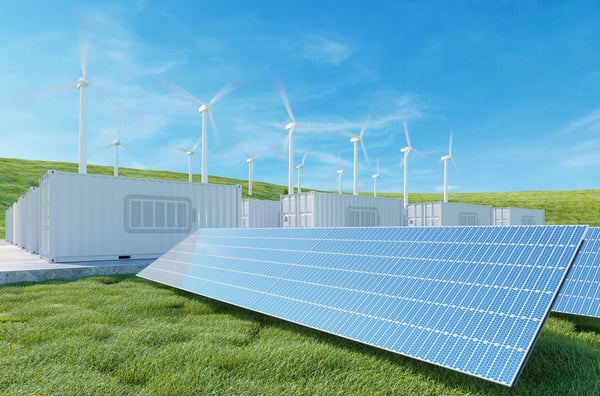Battery energy storage systems (BESS) are not only the talk of the power generation industry but are vital in meeting net-zero clean energy goals.
Favorable policies combined with falling costs and an increased appreciation for energy storage benefits have created an environment for rapid market growth. Let's explore energy storage industry trends for 2022.
First, why is energy storage so crucial for renewable energy?
The entire power generation system is slowly but steadily moving away from traditional synchronously-connected generators and towards inverter-based resources (IBRs) like solar and wind.
The challenge of an inverter-based renewable power generation system is the intermittent nature of solar and wind. Production goes up when the sun is shining or the wind is blowing but goes down when the day is overcast or the winds calm. BESS complements these renewable energy assets to ensure a reliable supply of energy to the grid.
Energy storage systems will play a key role in providing the requisite stability, reliability and resilience to the grid, especially when more and more IBRs are becoming part of the power grid system.
Learn more about how energy storage systems support the grid.
How promising is the growth trend for BESS?
The growth trend for BESS is strong, with no signs of slowing down. According to BloombergNEF's 2021 Global Energy Storage Outlook:
- The global energy storage market is set to hit one terawatt hour by 2030.
- BNEF estimates that 345 gigawatts/999 gigawatt-hours of new energy storage capacity will be added globally between 2021 and 2030.
- The forecast suggests that 55% of energy storage built by 2030 will provide energy shifting (such as storing solar or wind energy to release later).
A 2020 P&S Market Research study projects that the global energy storage market will add as much as 69,918 megawatts in capacity by 2030, exhibiting a CAGR of 3.3%.
What are the main trends driving the BESS market?
Five trends currently drive the BESS market: affordability, flexibility, evolving battery technology, second-life batteries and virtual power plants.
1. Affordability
Battery storage prices are dropping at an annual rate of more than 8%—far beyond industry predictions. Not only that, they're expected to stay that way for a long time.
NREL is a national renewable energy laboratory of the U.S. Department of Energy. In the Cost Projections for Utility-Scale Battery Storage: 2021 Update, NREL projects cost reductions of 28%–58% by 2030 and 28%–75% by 2050.
Much of the affordability of battery storage is due to the expanding energy vehicle (EV) market. The power generation sector benefits from the R&D and manufacturing economies of scale driven by the EV market.
2. Flexibility
BESS is very flexible and can be deployed quickly. It's both an electricity resource that generates and a load that can consume electricity. In both roles, BESS provides ample capabilities for stabilizing the grid, providing backup or supplemental electricity, and a host of other benefits. This immense flexibility is valuable for investors, utilities, grid operators and end-users. This flexibility also makes storage a natural complement to other rapidly growing renewable energy assets like solar and wind.
3. Evolving Battery Technology
Lithium-ion is the primary technology used in both BESS and EVs. The low cost of lithium-ion paired with increased demand for EVs has led to supply imbalances. However, the industry is researching and developing new battery chemistries. Among these are sodium-ion batteries, flow batteries and iron-air batteries. While not yet at the level of lithium-ion, these battery technologies are steadily reaching the commercial production stage.
4. Second-Life Batteries
EVs have more stringent battery requirements than other markets, and the batteries degrade significantly over the first five years of EV use. The batteries may no longer meet EV standards at that point—but they still have plenty of useful life left. They can have a second life in stationary energy storage applications that require less frequent battery cycling, such as reserve energy storage. By 2025, second-life batteries are expected to be 30%–70% less expensive than new batteries for the same applications.
5. Virtual Power Plants
Virtual power plants are a recent and exciting trend. As countries modernize their grids, they are considering new ways to boost grid resilience in the face of severe weather. The U.S. got a wake-up call in the form of Winter Storm Uri in February 2021. This devastating storm caused one of the largest blackout events in modern U.S. history.
Virtual power plants involve merging a group of BESS installed at distributed locations in residential or smaller complexes. This stored energy from different distributed resources can be consolidated and utilized to provide resilience to the grid. Virtual power plants can help utilities provide stable and reliable power to their customers without relying solely on U.S. infrastructure investment in new transmission lines.
How are government policies helping the BESS market?
Governments worldwide are growing increasingly proactive in promoting their aggressive net-zero targets. This translates to favorable policies and incentives for the BESS market. Various state and federal investment tax credit benefits are available for companies adding energy storage systems to their eligible solar projects.
Some states and the federal government are considering exclusive ITC benefits for storage-only installations.
Governments and agencies are also working to open the U.S. wholesale electricity market to fast-responding resources like batteries and flywheels. Landmark FERC orders 841 and 2222 open wholesale markets to emerging technologies including distributed resources.
What are the new business model trends in regards to energy storage?
There are three significant emerging business model trends: the new LCOS matrix, increased availability of early-stage funding, and energy storage as a service (ESaaS).
1. Levelized Cost of Storage (LCOS) Matrix
Many companies are jumping on the BESS opportunity and floating new business ideas. One of the most important questions is: How effective is BESS in helping them meet their goals?
A typical matrix used for energy resources is Levelized Cost of Energy (LCOE). Lately, we're seeing a new matrix emerge: Levelized Cost of Storage (LCOS). This evolving matrix helps generators and investors analyze and calculate the generation capacity reliability BESS can offer in the long run. Stakeholders can make more intelligent decisions on how to support their projects.
2. Early-Stage Funding
Early-stage funding for new battery storage companies is seeing robust growth. The IEA World Energy Investment 2021 Report posits that this increased willingness to provide risk capital is a strong positive indicator for the energy storage industry. Investors are more than just hungry for startups—they understand that the transition to inverter-based resources is real and underway.
3. Energy Storage as a Service (ESaaS)
Large-scale energy storage deployments and a promising future have resulted in a new business model. Energy Storage as a Service (ESaaS) aggregates customer-sited storage to provide a range of services to utilities, grid operators and consumers. We are seeing several ESaaS providers emerge—both new companies and existing companies that have diversified their offerings. ESaaS providers use AI, blockchain and productive analytics to aggregate battery storage, resulting in greater flexibility for utilities and more choice for residential and C&I customers.
What are some of the BESS capability trends?

BESS has been in use for a long time. What we are seeing now is the growth of BESS to grid-scale. BESS is reaching the stage where it can complement any renewable resource or act as a standalone distributed generation system. As energy storage systems are becoming bigger i.e., utility or grid scale, the deployments are getting supersized. For example, Florida Power & Light is developing a solar power battery for a 400MW/900MWh project. When operational, it will be one of the largest in the world.
BESS is also being utilized with grid-forming inverters to provide necessary grid stabilization as more and more IBRs come online. The largest planned grid-forming battery in the world, the Torrens Island project in South Australia, is expected to reveal much about the promising new technology's capability. The project is a 250-megawatt energy storage system, with SMA providing hundreds of grid-forming inverters for the site.
Nor-Cal can help you keep pace with energy storage market trends.
Nor-Cal Controls has a strong track record of success with BESS projects of various sizes, led by our engineering, project management and network engineers teams. We are capable and fully geared to meet energy storage trends. We work closely with our customers to understand their project needs and take pride in meeting them.
If you need a custom solution that can help you take advantage of all the benefits BESS has to offer, contact us today. Whether you need a PV + Storage integration or a standalone BESS, we're happy to talk with you about your options. Schedule a call with us today.





